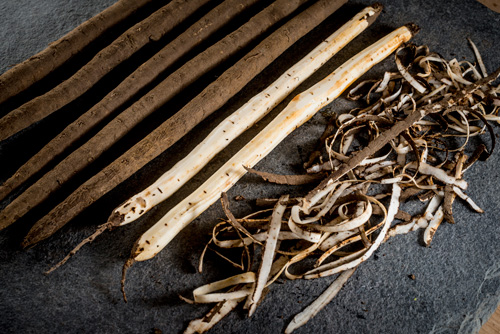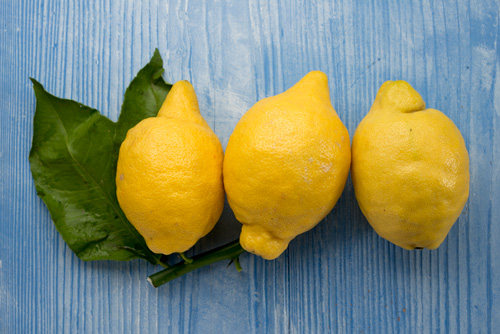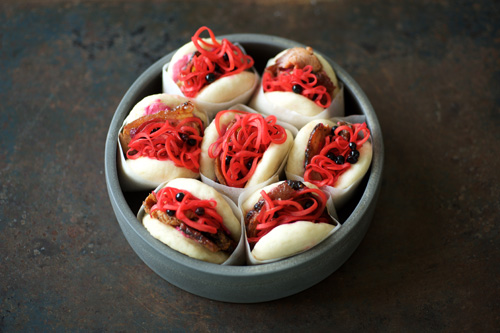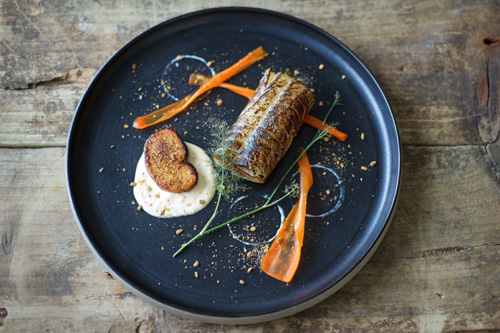What's in Season: October
Autumn is coming around again, and with it comes plenty of new produce for fresh food supplier James Wellock to recommend, and for chef-consultant Madalene Bonvini-Hamel to turn into timely dishes
Pumpkins are the classic autumnal choice as they abound at this time of year. The French Musquée de Provence pumpkin seems to have become the chefs' favourite over the past few years. It has a great flavour and less water content than the traditional Halloween pumpkins previously used.
There has been a big growth in the varieties of squashes from local growers and each type has a different twist: Harlequin, Spaghetti, Table Star, Orange Kabocha, Crown Prince, Blue Ballet, Patison Strie, Sunburst, Casperita, Gem, Delicata, Sweet Dumpling, Sweet Lightning - the list is almost endless! Squashes will be available alongside mixed gourds and Wee-B-Little and Munchkin pumpkins. All are around £1 per kilo, which means they're good from a gross profit point of view, too.
October is all about roots and tubers. Jerusalem artichokes started last month, and are now joined by the Chinese artichoke tuber, or crosnes. These small tubers have a delicious nutty flavour and a little crunch. Their price will come down as we get further into the season.
Parsley root will now be at its best - serve it in soups and stews, stir fries, or grated in salads - it tastes similar to a carrot but has a stronger flavour. Before 1920, the parsley root was used widely across Europe, but died away as production methods became unsustainable. But it is now firmly back on every chef's most-wanted list.
Chervil root is also making a comeback. The edible root looks like a dark grey carrot with yellowish-white flesh and can be boiled, fried or mashed. Another favourite is salsify, which becomes available from October. Believe it or not, it belongs to the sunflower family - as does the Jerusalem artichoke. Skirret, a sweet root vegetable, is also back on the menu - it can be stewed, baked, roasted, fried in batter as a fritter, creamed or grated and used raw in salads.
Nasturtium root or mashua has a reputation for its strong flavour - and also as an aphrodisiac. Roasted mashua tubers are considered a delicacy, and the raw tubers can be shredded thinly and used in salads to add a spicy flavour and crunchy texture.
We will still have wonderful cobnuts, but make sure you make the most of them now as they're coming to the end of their season.
From Italy we will have some brilliant puntarella, which is used in a traditional Roman salad. This is prepared by stripping the leaves and soaking the shoots in cold water until they curl. The pleasantly bitter salad is served with a dressing of anchovy, garlic, vinegar and salt pounded together and emulsified with olive oil. The fantastic cime di rape, a very popular vegetable in the south of Italy, is also available in October - it smells amazing and the flavour is outstanding.
It would be remiss to forget the leafy lemons from Sicily. They are full of flavour, have juice in abundance and the leaf is not just decorative - when rubbed it gives off the most amazing smell and oil.
We will be getting some great pears now with Comice, Williams and Conference being the main choices. With any type of fruit, it should be picked when it's almost ready to eat and the flavour and juice are just bursting out. The best choice here is the Comice.
The aroma of autumn black truffles as they are being unpacked is unbeatable. It fills the air as October continues and is a sure sign that autumn is well under way. Another clear sign is the first fresh chestnuts and cranÂberries, which will appear towards the end of the month. There are still lots of amazing plums, figs, kiwis and muscat grapes.
UK onions will be here, and it pays to go for these over the large, easy-to-prepare but flavourless Spanish option. English onions have far less water content - they feel like iron and will make your eyes water.
You will also have a great choice of baby potatoes - Ratte, Belle de Fontenay, Vitelotte and Grenaille from France, and Heritage Royal Kidney and Scottish Anya from the UK.
Barbecue brisket buns with beetroot and elderberry pickles
Makes 20 buns
For the barbecue beef brisket
- 1 star anise
- 2 garlic cloves, peeled
- 25g sea salt
- 1tsp English mustard powder
- 1tsp smoked paprika
- 1tsp whole black peppercorns
- 75g demerara sugar
- 1.2kg beef brisket
For the steamed buns
- 200ml full-fat milk
- 20g fresh yeast (or 7g dried yeast)
- 375g strong white-bread flour
- 40g suet
- ½tsp bicarbonate of soda
- ½tsp baking powder
- 1tsp caster sugar
- ½tsp sea salt
For the pickled golden beetroot and elderberries
- 100g caster sugar
- 100ml cider vinegar
- 1 garlic clove, crushed
- 100g elderberries, stalks removed
- 2 raw golden beetroots, peeled
- Sea salt and freshly cracked black pepper
For the beetroot mayonnaise
- 100g cooked and peeled ruby beetroot, roughly diced
- 1 egg yolk
- 1tsp Dijon mustard
- 1tbs lemon juice
- Sea salt and freshly cracked black pepper
- 120ml sunflower oil
First prepare the beef brisket. Make the spice rub by placing the star anise, garlic, salt, mustard powder, paprika and peppercorns in a pestle and mortar, pounding until fine and stirring in the sugar. Prepare the meat by drying it using kitchen paper and rubbing the spice rub over it. Place the beef in a vacuum bag and seal on hard vacuum. Place in the fridge for six hours.
Preheat the barbecue (a ceramic-style one with a lid and thermometer is recommended) to 160°C, ensuring there are enough coals for a cooking duration of eight hours.
Remove the beef from the vacuum pouch and place on the preheated barbecue, then close the lid and vents. Reduce the heat gradually over a period of two hours to 80°C and continue cooking the beef for further five hours at that temperature. Then gradually increase the heat back to 160°C for a further hour, bringing the total cooking time to eight hours. Turn the beef regularly for even colouring. Once cooked, wrap in foil and rest for 20 minutes before using.
For the steamed buns, heat the milk to 37°C and flake the yeast into it. Stir to dissolve and cover with clingfilm before setting aside for 10 minutes until it starts to froth. Place the rest of the dry ingredients in a large mixing bowl, make a well in the centre and add the milk and make a dough. Knead the dough for eight minutes until smooth and place in a lightly greased bowl. Cover with a dry tea towel and set aside to prove for about 45 to 50 minutes until it has doubled in size.
Knock the dough back, divide into 20g balls and roll each ball to a 3cm-thick oval shape. Brush the surfaces with sunflower oil and fold them over to make half moons. Place them on baking paper on a tray, cover lightly with a dry tea towel and leave to prove for the second time for about 20 minutes. Steam the buns in a preheated steamer for 10 minutes until fully risen and cooked.
For the pickled golden beetroot and elderberries, dissolve the sugar in the vinegar with the garlic and seasoning in a small saucepan over a medium heat. Once dissolved, bring to a gentle simmer for three minutes, then add the elderberries and bring back to the boil before removing from the heat. Use a spiralizer to cut the beetroot into shoestrings, then add this to the warm pickling liquid and elderberries. Place in a clean container and set aside to cool completely, then refrigerate until needed.
For the beetroot mayonnaise, place the cooked diced beetroot, egg yolk, mustard, lemon juice and seasoning in a blender and blend until smooth. Then slowly add the oil to form a mayonnaise, tasting and adjusting the seasoning if needed. Keep chilled.
To serve, open the warm steamed buns and spread mayonnaise on one side. Slice the beef into thin slivers, or flake. Place a portion of beef in each bun, top with drained pickles and serve.
Cod, smoked cod's roe, carrot and fenugreek
Serves 6
For the carrot and fenugreek mayonnaise
- 100g carrots, peeled and diced
- 1 garlic clove, crushed
- 1tsp fenugreek
- 1tsp clear runny honey
- Sea salt and freshly cracked black pepper
- 500ml full-fat milk (as fresh as possible)
- 2tbs thick Greek yogurt with live active yogurt cultures (L. bulgaricus, bifidus, S. thermophilus, L. acidophilus, L. casei)
For the ginger pickled carrot
- 60g caster sugar
- 60ml mirin
- 60ml rice wine vinegar
- 40g fresh ginger, peeled and sliced
- 2 carrots, peeled
- Sea salt and freshly cracked black pepper
For the cod
- 6 x 80g skinless pieces of cod fillet, pin bones removed
- 2tbs table salt
- 1tbs rapeseed oil
- 6 x 20g slices of smoked cod roe
To serve
- 1tsp fenugreek
- 6 fennel fronds
First prepare the carrot and fenugreek yogurt, starting this process one day in advance. Either use a yogurt maker, or preheat a waterbath to 42°C . Cook the carrot and garlic in a pan with water for 15 to 20 minutes until very soft, and then drain and purée until smooth with the fenugreek, honey and seasoning. Cool until 42°C. In the meantime, heat the milk to 90°C and then cool to 42°C.
Once the milk reaches 42°C, stir in the yogurt and carrot purée and transfer to a container that fits in the waterbath. Cover the container with a lid or clingfilm and place in the preheated waterbath for eight hours (the longer you leave it, the thicker and tastier the yogurt will be). It's important not to disturb, mix or shake the mixture during this incubation period. Once the eight hours is complete, carefully transfer the yogurt to a large sieve lined with muslin cloth and set over a bowl in the fridge to drain for approximately two hours (overnight is also great). Once drained, place the thick yogurt in a clean container and keep chilled until needed. The yogurt will keep for up to seven days.
Prepare the carrot pickle. Dissolve the sugar in the mirin and vinegar with ginger and seasoning over a medium heat. Once dissolved, increase the heat to simmer for three minutes. Slice the carrots into long, thin ribbons using a mandolin. Let the pickling liquid cool, then add the carrot and vacuum on hard seal. Chill until needed.
For the cod, sprinkle over the salt and set aside to cure for 10 minutes. Wash and dry the fillets on kitchen paper. Place them in a vacuum pouch and seal on hard vacuum. Cook in the waterbath at 45°C for 10 minutes, then drain and place on a metal tray before patting dry with kitchen paper. Use a blowtorch to scorch the cod and then brush with the oil.
For the cod's roe, heat a small, non-stick frying pan over a high heat and pan-fry the roe for 10 seconds on each side. To serve, garnish each plate with the yogurt and place a piece of cod on each with one slice of the cod roe. Garnish with the drained pickled carrot, sprinkle over the fenugreek, then place a fennel frond on each plate and serve.
















